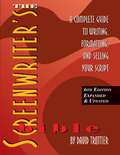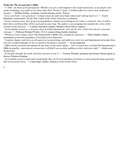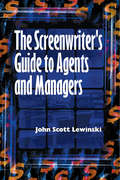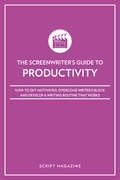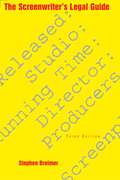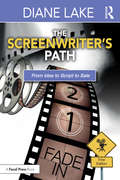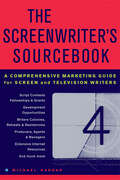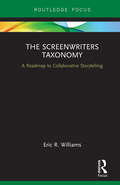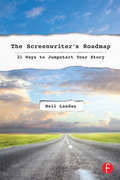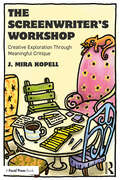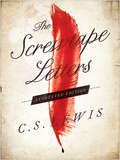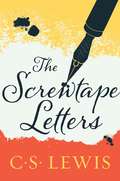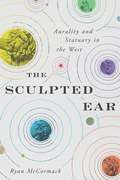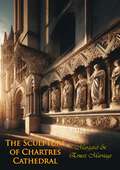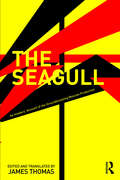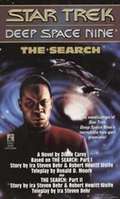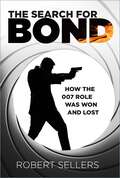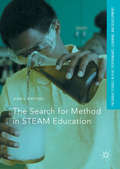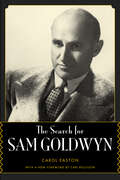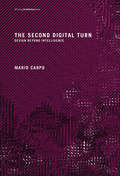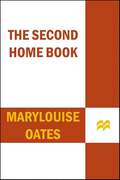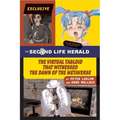- Table View
- List View
The Screenwriter Within: How to Turn the Movie in Your Head into a Salable Screenplay
by D. B. GillesIf you've ever dreamed of writing a screenplay,The Screenwriter Withinis the book for you. Insightful, inspirational, and wildly irreverent, it takes you through all the stages of the writing process, using references to hit movies and the author's personal experience to show you how to: Turn everyday events into big-screen successes Find the best stories to turn into screenplays Develop strong characters Write compelling dialogue Find your niche as a screenwriter . . . and much more.
The Screenwriter's Bible: A Complete Guide To Writing, Formatting, And Selling Your Script
by David TrottierThe Bible is five books bound into a single volume. -- a screenwriting primer (provides a concise presentation of screenwriting basics) -- a formatting guide (presents both correct screenplay and teleplay formats) -- a screenwriting workbook (the writing process, from nascent ideas to revisions) -- a sales and marketing guide (offers a marketing plan and sales strategies) -- a resource guide (provides contacts for industry organizations, guilds and unions, schools, publications, support groups and services, contests, etc.)
The Screenwriter's Bible: A Complete Guide to Writing, Formatting, and Selling Your Script
by David TrottierThe Screenwriter s Bible's 7th edition marks the 25th anniversary of one of the most popular, authoritative, and useful books on screenwriting. A standard by which other screenwriting books are measured, it has sold over 340,000 copies in its 25-year life. Always up-to-date and reliable, it contains everything that both the budding and working screenwriter need under one cover five books in one!
The Screenwriter's Guide to Agents and Managers
by John Scott LewinskiThe lessons to be learned from this helpful guide show aspiring screenwriters, television writers, and novelists how to catch an agent's eye and develop a successful scriptwriting career. Step-by-step instructions reveal how to get around the "Catch 22" of the trade-that you can't get an agent until you've sold a script. Interviews with prominent agents and managers disclose how the power brokers choose material, what kinds of writers command their attention, and what they expect from the writers they sign on. Tips on how to write a winning spec script, how to word an effective query letter, how to forge a sound relationship with reps, and other invaluable advice fill this insider's guide.
The Screenwriter's Guide to Productivity: How to Get Motivated, Overcome Writer's Block and Develop a Writing Routine That Works
by Script Magazine EditorsAre you an aspiring screenwriter, but struggling to get the words on the page? So many things can come between you and the keyboard: a 9 - 5 job, writer's block, or good old-fashioned procrastination. Writing Routine and Outlook is a collection of articles from Script Magazine that address the many obstacles that independent screenwriters face when trying to hone their craft. Film industry experts provide advice based on their own experiences and useful tips for making writing a part of your everyday life. Getting in the zone to write can be hard, but there are ways to cut down on the time it takes for you to focus up. These articles will teach you how to make writing into a habit, regardless of how busy you are. You'll learn how to find your optimal time of day for creation and productivity, your own writing process, and a work-life balance. By evaluating the way you currently make use of your time, you'll learn how to restructure your days to make the most of them. You'll learn how setting goals and deadlines for yourself can transform your writing experience, how to avoid the trap of waiting for inspiration, and how to select a day job that pays the bills while facilitating your passion. Writing Routine and Outlook also includes tips for boosting your creativity, finishing your screenplay, and turning your procrastination into productivity.
The Screenwriter's Legal Guide: Third Edition
by Stephen BreimerThis authoritative guide will help both fledgling and established writers to negotiate the best deal, protect their work, and get fair compensation for it. One of the most powerful entertainment lawyers in Hollywood provides easy-to-understand, expert advice on all the legal issues involved in the business of screenwriting. He gives an enlightening explanation of the screenwriter's position in the industry and then provides a thorough discussion of contracts, options, and working with agents and lawyers. This book shows screenwriters what to give up as a lost cause and what to hold out for.
The Screenwriter's Path: From Idea to Script to Sale
by Diane LakeThe Screenwriter’s Path takes a comprehensive approach to learning how to write a screenplay—allowing the writer to use it as both a reference and a guide in constructing a script. A tenured professor of screenwriting at Emerson College in Boston, author Diane Lake has 20 years' experience writing screenplays for major studios and was a co-writer of the Academy-award winning film Frida. The book sets out a unique approach to story structure and characterization that takes writers, step by step, to a completed screenplay, and it is full of practical advice on what to do with the finished script to get it seen by the right people. By demystifying the process of writing a screenplay, Lake empowers any writer to bring their vision to the screen.
The Screenwriter's Sourcebook: A Comprehensive Marketing Guide for Screen and Television Writers
by Michael HaddadWritten for both new and experienced writers, this comprehensive marketing guide offers advice and tips needed by writers to succeed in the film and television industries. Focusing on the business of writing, it gives writers the unabashed truth about the film industry, and advice on how to get scripts to the gatekeepers of the studios and read by agents. Comprehensive listings of contests, fellowships, grants, and development opportunities from an industry expert provide specific information on securing a healthy writing career. This extensive resource also includes guidelines regarding copyrights, sources for emergency funds, a listing of online resources, information on writers' colonies and retreats, and more.
The Screenwriters Taxonomy: A Collaborative Approach to Creative Storytelling
by Eric WilliamsIn The Screenwriters Taxonomy, award-winning screenwriter and educator Eric R. Williams offers a new collaborative approach for creative storytellers to recognize, discuss and reinvent storytelling paradigms. Williams presents seven different aspects of storytelling that can be applied to any fictional narrative film—from super genre, macrogenre and microgenre to voice and point of view—allowing writers to analyze existing films and innovate on these structures in their own stories. Moving beyond film theory, Williams describes how this roadmap for creative decision making can relate to classics like Sunset Boulevard, The Wizard of Oz and Butch Cassidy and the Sundance Kid as well as such diverse modern favorites like 12 Years a Slave, Anomalisa and Shrek.
The Screenwriter’s Roadmap: 21 Ways to Jumpstart Your Story
by Neil LandauFinally, a GPS system for screenwriters!The potentially long and arduous journey of writing a screenplay was just made easier to navigate with The Screenwriter's Roadmap. Avoid the wrong turns, dead ends, gaping p(l)otholes, and other obstacles that result in frustration , wasted time, and wasted energy. The Screenwriter's Roadmap keeps you on track and helps you reach your destination- a finished, professional quality screenplay.Neil Landau, a successful Hollywood screenwriter and script doctor with over 2 decades of experience, provides you with 21 Guideposts, that if implemented, will help you nail down your screenplay's story structure, deepen its character arcs, bolster stakes, heighten suspense, and diagnose and repair its potential weaknesses. These Guideposts are based on field-tested, in-the-trenches experiences that have been proven to work. The Guideposts are augmented by interactive exercises, end of chapter "homework" assignments, examples from the latest blockbusters, as well as over 20 interviews with some of Hollywood's most successful screenwriters and directors, including David S. Goyer (Batman Begins, The Dark Knight, The Dark Knight Rises, Man of Steel), David Koepp (Jurassic Park, Mission: Impossible, Spider-Man, Panic Room, War of the Worlds, Angels & Demons), Melissa Rosenberg (The Twilight Saga: Twilight, The Twilight Saga: New Moon, The Twilight Saga: Eclipse, The Twilight Saga: Breaking Dawn - Part 1, The Twilight Saga: Breaking Dawn - Part 2, Dexter (TV)), and Eric Roth (Forrest Gump, The Insider, Munich, The Good Shepherd, The Curious Case of Benjamin Button, Extremely Loud and Incredibly Close). .
The Screenwriter’s Workshop: Creative Exploration Through Meaningful Critique
by J. Mira KopellThrough a series of carefully designed writing workshops, this book guides the screenwriter through the messy creativity of screenwriting. Drawing on over 20 years’ experience facilitating screenwriting workshops, author J. Mira Kopell provides readers with a path to screenwriting that makes space for reflection, critique, and exploration. Structured around five specific writing assignments, each assignment supports the writer forward incrementally by focusing on a specific set of craft elements needed to then move them on to the next. A key value of the assignments is that they are not exercises but steps in the development of the writer's own screenplay. By using this book, readers can both receive meaningful feedback on their own project and learn to give insightful, focused critiques of their fellow writer’s work. Rather than offering craft as a “to-do” list that promises successful scripts, this book reimagines craft as “tools not rules,” empowering a writer to let their unique story dictate choices in order to support their work and honor their own voice. This book is ideal for students and lecturers of screenwriting, groups of writers looking to form their own workshops, and aspiring professionals wanting to develop their craft.
The Screwtape Letters: Annotated Edition
by C. S. LewisA masterpiece of satire, this classic has entertained and enlightened readers the world over with its sly and ironic portrayal of human life from the vantage point of Screwtape, a senior tempter in the service of "Our Father Below." At once wildly comic, deadly serious, and strikingly original, C. S. Lewis gives us the correspondence of the worldly-wise old devil to his nephew Wormwood, a novice demon in charge of securing the damnation of an ordinary young man. The Screwtape Letters is the most engaging and humorous account of temptation--and triumph over it--ever written.Now, for the first time, The Screwtape Letters is presented with its full text alongside helpful annotations provided by Lewis enthusiast and dramatist Paul McCusker. The notes include literary, theological, and biographical information to enhance Lewis's core themes and demystify complex ideas. McCusker also guides readers to concepts and references from the beloved author's other treasured volumes to deepen and enrich this timeless classic. The annotated edition is the ultimate guide for understanding the heavenly truths buried in these epistles from below.
The Screwtape Letters: Letters From A Senior To A Junior Devil
by C. S. LewisIn this humorous and perceptive exchange between two devils, C. S. Lewis delves into moral questions about good vs. evil, temptation, repentance, and grace. Through this wonderful tale, the reader emerges with a better understanding of what it means to live a faithful life.
The Sculpted Ear: Aurality and Statuary in the West (Perspectives on Sensory History #2)
by Ryan McCormackSound and statuary have had a complicated relationship in Western aesthetic thought since antiquity. Taking as its focus the sounding statue—a type of anthropocentric statue that invites the viewer to imagine sounds the statue might make—Sculpted Ears rethinks this relationship in light of discourses on aurality emerging within the field of sound studies. Ryan McCormack argues that the sounding statue is best thought of not as an aesthetic object but as an event heard by people and subsequently conceptualized into being through acts of writing and performance.Constructing a history in which hearing plays an integral role in ideas about anthropocentric statuary, McCormack begins with the ancient sculpture of Laocoön, before moving to a discussion of the early modern automaton known as Tipu’s Tiger and the statue of the Commendatore in Mozart’s Don Giovanni. Finally, he examines statues of people from the present and the past, including the singer Josephine Baker, the violinist Aleksandar Nikolov, and the actor Bob Newhart—with each case touching on some of the issues that have historically plagued the aesthetic viability of the sounding statue. McCormack convincingly demonstrates how sounding statues served as important precursors and continuing contributors to modern ideas about the ontology of sound, technologies of sound reproduction, and performance practices blurring traditional divides between music, sculpture, and the other arts.A compelling narrative that illuminates the stories of individual sculptural objects and the audiences that hear them, this book will appeal to anyone interested in the connections between aurality and statues in the Western world, in particular scholars and students of sound studies and sensory history.
The Sculpted Ear: Aurality and Statuary in the West (Perspectives on Sensory History)
by Ryan McCormackSound and statuary have had a complicated relationship in Western aesthetic thought since antiquity. Taking as its focus the sounding statue—a type of anthropocentric statue that invites the viewer to imagine sounds the statue might make—The Sculpted Ear rethinks this relationship in light of discourses on aurality emerging within the field of sound studies. Ryan McCormack argues that the sounding statue is best thought of not as an aesthetic object but as an event heard by people and subsequently conceptualized into being through acts of writing and performance.Constructing a history in which hearing plays an integral role in ideas about anthropocentric statuary, McCormack begins with the ancient sculpture of Laocoön before moving to a discussion of the early modern automaton known as Tipu’s Tiger and the statue of the Commendatore in Mozart’s Don Giovanni. Finally, he examines statues of people from the present and the past, including the singer Josephine Baker, the violinist Aleksandar Nikolov, and the actor Bob Newhart—with each case touching on some of the issues that have historically plagued the aesthetic viability of the sounding statue. McCormack convincingly demonstrates how sounding statues have served as important precursors and continuing contributors to modern ideas about the ontology of sound, technologies of sound reproduction, and performance practices blurring traditional divides between music, sculpture, and the other arts.A compelling narrative that illuminates the stories of individual sculptural objects and the audiences that hear them, this book will appeal to anyone interested in the connections between aurality and statues in the Western world, in particular scholars and students of sound studies and sensory history.
The Sculpture of Chartres Cathedral: Text In English And French; Texte Francais Et Anglais (classic Reprint)
by Margaret Marriage Ernest Marriage“The book ""Sculptures of Chartres Cathedral"" by Margaret Marriage is a comprehensive guide to the magnificent sculptures that adorn the Chartres Cathedral in France. The book provides a detailed account of the history of the cathedral and its sculptures, as well as an analysis of the artistic techniques and styles used to create them. The book is divided into several chapters, each of which focuses on a different aspect of the sculptures. The first chapter provides an overview of the cathedral and its history, while the second chapter explores the iconography of the sculptures and the religious themes they represent. The third chapter delves into the technical aspects of the sculptures, such as the materials used and the methods of construction. The fourth chapter examines the influence of different artistic styles on the sculptures, including Romanesque and Gothic. The book also includes numerous photographs and illustrations to help readers visualize the sculptures and understand their significance. Overall, ""Sculptures of Chartres Cathedral"" is an essential resource for anyone interested in medieval art and architecture, and a must-read for those planning a visit to the Chartres Cathedral... It deals mainly with the sculptures on the doorway, although there are views of the general architecture and a few subjects from the interior. Over 120 photographs,”-Print ed.
The Seagull: An Insiders’ Account of the Groundbreaking Moscow Production
by James Thomas Anatoly EfrosThis book is an insiders’ account of the groundbreaking Moscow production of Chekhov's The Seagull directed by Anatoly Efros in 1966, which heralded a paradigm shift in the interpretation and staging of Chekhov’s plays. It is a unique glimpse behind the curtain of the laboratory of new Russian theatre in the twentieth century. Efros' articles about Chekhov and The Seagull, his diaries, interviews and conversations, and most importantly the original rehearsal records combine to form an in-depth account of of the director and his working process. This is an essential book for anyone with an interest in Chekhov and the history of modern Russian theatre.
The Search (Star Trek )
by Diane CareyThe Dominion: The mysterious rulers of the worlds on the other side of the wormhole. The Dominion: a ruthless planet-conquering race unknown even to those they rule. The Dominion: the most dangerous foe the Federation may ever face. At the edge of the wormhole, the space station Deep Space Nine™and the planet Bajor sit on what will be the front line in any Dominion attack. To try and prevent the conflict, Commander Benjamin Sisko ant his crew take a never-tested Federation warship through the wormhole to track down and confront the Dominion. If Commander Sisko fails, not only the Federation, but the Klingons, Romluans, Cardassians, and all the worlds of the Alpha Quadrant will face an interstellar war they cannot win.
The Search for Bond: How the 007 Role Was Won and Lost
by Robert Sellers‘There are so many insights – even hardcore Bond fans will be surprised. Indispensable.’ – David Lowbridge-Ellis MBEOnly six men can lay claim to wearing the famous Savile Row tuxedo of James Bond; more people have stepped on the Moon. Yet, hundreds more came within an inch of winning the coveted 007 role – the pinnacle for so many actors.For the first time, The Search for Bond tells the extraordinary story of how cinema’s most famous secret agent was cast, featuring exclusive interviews with many of the actors who were at one time considered to play Bond, interviewed for the role, or went as far as to be screen tested. From Ranulph Fiennes to Colin Firth, their memories and stories give a fascinating insiders’ glimpse into the process of how the Bond producers, Broccoli and Saltzman, came up with the right man to play their famous spy.
The Search for Method in STEAM Education
by Jaime E. MartinezThis book explores various approaches to building a positive interdisciplinary STEAM (science, technology, engineering, arts and math) learning environment, as described by educators across the K-20 educational ladder. Crucial to their success, Martinez finds, is the playful and performatory approach they employ in their teaching. Their practices are creative, improvisational, and inclusive, and are shared in detail through illustrations and interviews. Throughout the book, the author explores a Vygotskian cultural performatory approach to creating interdisciplinary STEAM learning environments, drawing out the history of this approach and its success in fostering collaboration, creativity, leadership, and communication skills, as well as its effect on social, emotional, and cognitive growth in both formal and informal educational settings.
The Search for Sam Goldwyn (Hollywood Legends Series)
by Carol EastonSam Goldwyn's career spanned almost the entire history of Hollywood. He made his first film, The Squaw Man, in 1913, and he died in 1974 at the age of ninety-one. In the many years between, he produced an enormous number of films--including such classics as Wuthering Heights, Street Scene, Arrowsmith, Dodsworth, The Little Foxes, and The Best Years of Our Lives--and worked with many luminaries--Gary Cooper, Ronald Colman, Laurence Olivier, George Balanchine, Lillian Hellman, Howard Hawks, John Ford, Eddie Cantor, Busby Berkeley, Danny Kaye, Merle Oberon, and Bob Hope among them. When Samuel Goldfisch was born in the Warsaw ghetto, he was penniless; when Sam Goldwyn died in Los Angeles, he was worth an estimated $19 million. The Search for Sam Goldwyn locates the real Sam Goldwyn and shatters the "hostile conspiracy of silence" that protected his legend. In writing Goldwyn's story, Carol Easton has given us a fine examination of "the civilization known as Hollywood" and how Goldwyn himself shaped that culture.
The Second Digital Turn: Design Beyond Intelligence (Writing Architecture)
by Mario CarpoThe first digital turn in architecture changed our ways of making; the second changes our ways of thinking.Almost a generation ago, the early software for computer aided design and manufacturing (CAD/CAM) spawned a style of smooth and curving lines and surfaces that gave visible form to the first digital age, and left an indelible mark on contemporary architecture. But today's digitally intelligent architecture no longer looks that way. In The Second Digital Turn, Mario Carpo explains that this is because the design professions are now coming to terms with a new kind of digital tools they have adopted—no longer tools for making but tools for thinking. In the early 1990s the design professions were the first to intuit and interpret the new technical logic of the digital age: digital mass-customization (the use of digital tools to mass-produce variations at no extra cost) has already changed the way we produce and consume almost everything, and the same technology applied to commerce at large is now heralding a new society without scale—a flat marginal cost society where bigger markets will not make anything cheaper. But today, the unprecedented power of computation also favors a new kind of science where prediction can be based on sheer information retrieval, and form finding by simulation and optimization can replace deduction from mathematical formulas. Designers have been toying with machine thinking and machine learning for some time, and the apparently unfathomable complexity of the physical shapes they are now creating already expresses a new form of artificial intelligence, outside the tradition of modern science and alien to the organic logic of our mind.
The Second Home Book: The Can-Do, How-To, Get-Through Guide
by Marylouise OatesThe Ultimate Guide to Organize and Inspire You So You Can—Really!—Sit Back and Enjoy Your Second HomeThe Second Home Book is the first of its kind – a conversational, comprehensive and convenient guide to setting up, operating and, most of all, enjoying a second home. It is cheerful and useful—funny, fact-filled, anecdotal – appealing to both those already ensconced in or encumbered with a 2nd residence as well as those imagining a future, fantastic home.In The Second Home Book, you'll learn:--how to furnish your second home on a shoestring (without relying on castoffs from your primary residence)--how to run your second home efficiently from afar--how to assemble a dream team of helpers (from handymen to cleaning help) and keep them motivated--how to entertain (even other people's children) without exhausting yourself--why you should avoid renovating your second home's kitchen--how to handle bills, routine maintenance, and emergencies--how to turn any house into your dream houseThe Second Home Book is not about how to finance a second home—it's about absolutely everything else you need to know in one cheerful, easy-to-navigate volume.
The Second Life Herald: The Virtual Tabloid That Witnessed the Dawn of the Metaverse
by Peter Ludlow Mark WallaceLudlow and Wallace take us behind the scenes of the Herald as they report on the emergence of a fascinating universe of virtual spaces that will become the next generation of the World Wide Web: a 3-D environment that provides richer, more expressive interactions than the Web we know today.
The Second Mrs. Giaconda
by E. L. KonigsburgWhy did Leonardo da Vinci lavish three years on painting the second wife of an unimportant merchant when all the nobles of Europe were begging for a portrait by his hand? In E. L. Konigsburg's intriguing novel, the answer lies with the complex relationship between the genius, his morally questionable young apprentice, and a young duchess whose plain features belie the sensitivity of her soul.

